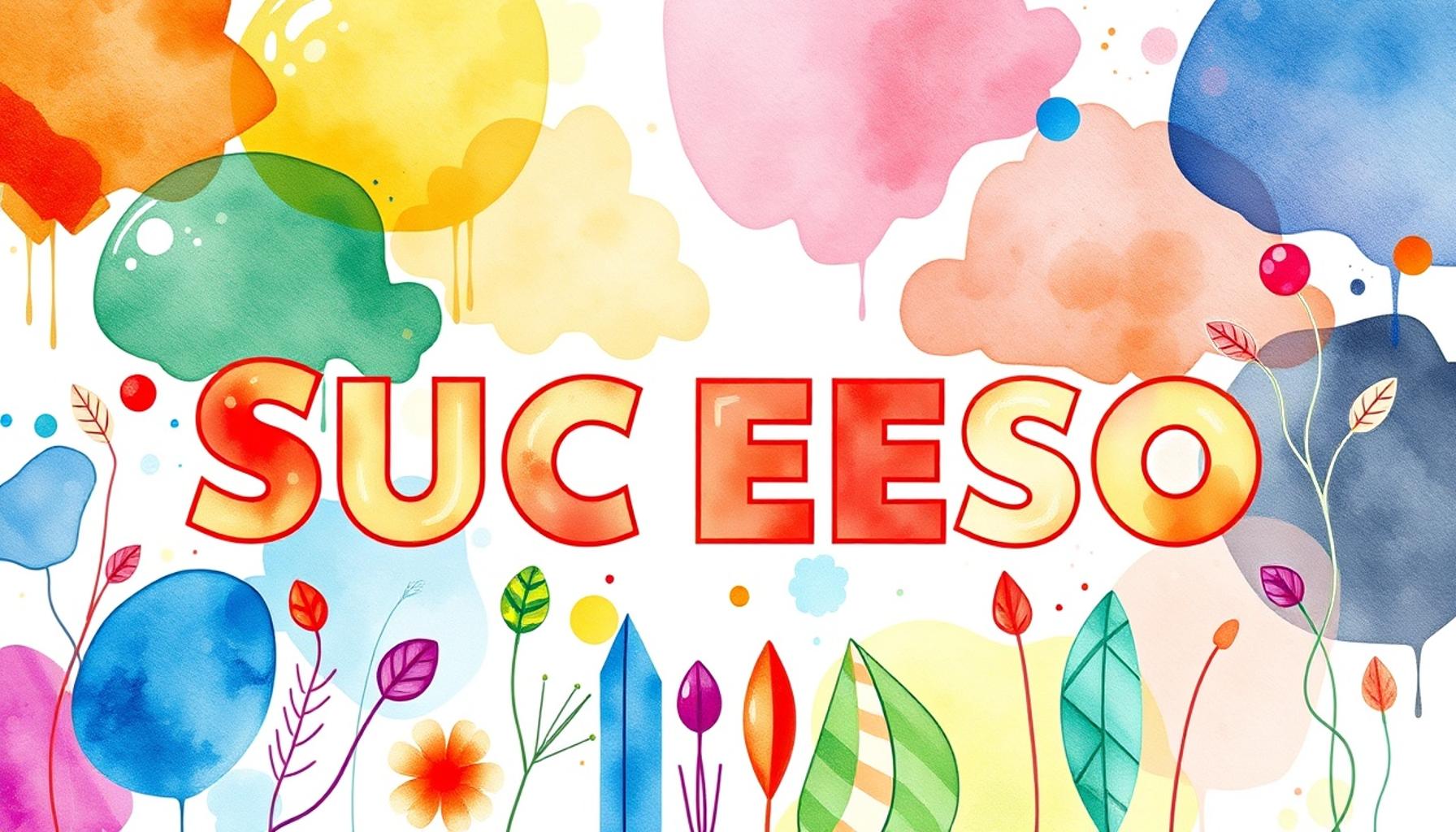Visualization of Success: The Impact of Mental Images on Creating a Positive Life

The Vision Behind Every Achievement
Every remarkable journey towards achievement starts with a vision. The power of mental imagery has been recognized as a crucial tool that can convert abstract dreams into concrete realities. In Nigeria, a nation brimming with diverse aspirations—ranging from academic accomplishments to entrepreneurial success—grasping the dynamics of visualization becomes imperative for both individuals and communities.
The interplay between our thoughts and tangible outcomes is a compelling area of study. For instance, students who frequently visualize themselves successfully navigating challenging exams report not only heightened confidence but also improved actual performance. By picturing exam scenarios and rehearsing responses mentally, they create a mental blueprint that prepares them for success.
A similar phenomenon can be observed in the corporate landscape. Among professionals, envisioning promotions or leading successful projects can stimulate motivation and drive. Many young Nigerian entrepreneurs are beginning to adopt visualization techniques to foresee their business milestones. By imagining a thriving marketplace and anticipating client interactions, they cultivate a productive mindset that empowers them to push boundaries and reach potential.
Moreover, the journey towards personal well-being is heavily influenced by the images we create in our minds. Individuals aiming for healthier lifestyles often benefit from visualizing their fitness goals and the vibrancy of their desired health. For Nigerians navigating the pressure of urban living, where fast food and sedentary lifestyles are prevalent, mental imagery can serve as a powerful motivator to adopt healthier eating habits and engage in regular physical activity.
Research underlines that athletes, such as sprinters and footballers, routinely use mental imagery to refine their skills and performance. Legendary figures like Nigerian sprinter Blessing Okagbare have articulated that envisioning winning races enhances their actual execution on the track. Furthermore, artists and creative professionals utilize visualization to bolster their artistic endeavors, channeling their imagination to forge exceptional work.
Visualization does not only serve the individual; it extends to influence a collective spirit within communities. In Nigeria, where the communal culture thrives, shared visions of success can foster unity and inspire collective action. Local initiatives focused on community development often showcase how groups capitalize on this practice to spur motivation and galvanize efforts towards common goals.
As we navigate through the impact of visualization and its various methods—from guided imagery to vision boards and affirmations—backed by expert insights and real-life examples, we invite you to explore how these mental images can pave the path to tangible achievements. Embrace this transformative tool and take a step towards crafting a vibrant, successful future.
SEE ALSO: Click here to read another article
The Mechanisms of Mental Imagery in Achieving Success
Understanding how to harness the power of visualization involves diving into the intricate mechanisms that govern our mental imagery. At the heart of visualization lies a profound psychology: the brain often cannot distinguish between actual experiences and vividly imagined scenarios. This phenomenon is rooted in neuroscience, where mental images activate similar areas of the brain as those triggered by real-life actions. For instance, when you visualize completing a task successfully, the same neural pathways illuminate as if you were engaging in that task physically. This concept plays a crucial role in preparing individuals for success.
In Nigeria, a growing number of schools and educational programs are incorporating visualization techniques into their curricula. The objective is simple yet powerful: to encourage students to create a mental framework that fosters their academic and personal growth. Research indicates that students who practice visualization report increased focus, reduced anxiety, and stronger retention of information. By visualizing the steps needed to tackle their studies, these young minds become mentally equipped to achieve their goals.
Practical Applications of Visualization Techniques
The practical application of visualization techniques can vary widely, but here are some of the most effective methods gaining traction:
- Guided Imagery: This method involves listening to a facilitator who guides individuals through a visualization process, enhancing relaxation and clarity.
- Vision Boards: Creating a physical collage of images and motivational quotes serves as a daily reminder of one’s goals, making success feel more attainable.
- Affirmations: Speaking positive affirmations while visualizing success reinforces a nurturing belief in one’s potential and capabilities.
These techniques are not merely new-age fads; they are supported by evidence from various studies backing their efficacy in bolstering confidence and motivation. For entrepreneurs in Nigeria, visualizing business opportunities and outcomes can remarkably enhance their creativity and strategic thinking. By imagining potential setbacks and crafting mental responses to overcome them, these individuals prepare themselves to handle challenges more adeptly.
A notable example is the growing trend of mentorship programs across Nigeria that emphasize the importance of visualization in business. Mentors encourage young entrepreneurs to envision their enterprises flourishing, strategizing on how to attract and retain customers while overcoming hurdles. This practice helps cultivate a resilient mindset, crucial for overcoming the unique challenges posed by a rapidly changing economic landscape.
Visualization is not just an isolated practice but a communal ethos in many Nigerian cultures. By sharing visions of success within families or community groups, members foster an environment that nurtures ambition and collective growth. This approach counters the individualistic tendencies of modern urban living, reinforcing the idea that success is not solely personal but a shared journey.
The journey into the realm of visualization—both individual and communal—now unfolds, offering insights into how these mental images shape realities and encourage the pursuit of a fulfilling life. As we explore further the techniques, benefits, and testimonies surrounding visualization of success, we unlock the door to transformative possibilities available to individuals and communities alike.
Exploring Mental Imagery and Its Benefits
The concept of mental imagery goes beyond mere daydreaming; it is a powerful cognitive tool that can shape our reality. When we consciously visualize our goals and aspirations, we engage in a process that not only fosters creativity but also enhances motivation and resilience. Through effective mental imagery, we create a roadmap in our mind, guiding us toward achieving our aims with greater clarity and focus. Research has shown that individuals who regularly practice visualization techniques experience a heightened sense of self-efficacy. This boost in confidence can lead to improved performance in various aspects of life, from professional endeavors to personal relationships. Furthermore, the physiological effects of positive mental imagery are notable; studies indicate that mental rehearsal can stimulate brain activity similar to physical practice. This phenomenon underscores the profound connection between our thoughts and our capacity to enact change.Successful athletes often utilize visualization techniques as part of their training regimen. By mentally rehearsing their routines, they enhance muscle memory and prepare themselves for competition. This practice not only prepares them physically but also cultivates a winning mindset, illustrating the integral role of mental images in achieving success.But the benefits of visualization are not confined to the realm of sports. Entrepreneurs, artists, and leaders in various fields leverage these techniques to manifest their visions and drive innovation. By picturing success vividly in their minds, they attract opportunities and foster a positive attitude that propels them forward despite challenges.Incorporating visualization exercises into daily life can be as simple as setting aside a few minutes each day to visualize specific goals. Whether it’s envisioning a successful presentation or picturing financial stability, these practices can lead to tangible results. The more detailed and emotionally charged the imagery, the stronger its impact on reality.To further delve into the advantages of visualization and how it can alter the trajectory of your life, let’s examine a structured approach through the following table.
| Category | Benefits |
|---|---|
| Boosting Self-Efficacy | Enhances belief in one’s abilities, leading to improved performance. |
| Enhancing Motivation | Increases drive to pursue goals actively and pursue personal growth. |
| Improved Resilience | Develops coping strategies, enabling individuals to overcome obstacles. |
| Cognitive Clarity | Provides a clear vision of desired goals, promoting focused actions. |
By embracing the power of visualization, individuals can tap into their potential to create a fulfilling and positive life. In the following sections, we will explore practical strategies to incorporate this powerful technique into everyday routines.
ADDITIONAL INSIGHTS: Expand your understanding here
Real-Life Transformations Through Visualization
As the understanding of the impact of mental imagery grows, real-life transformations are being documented, showcasing the profound effects of visualization techniques on various aspects of life. In Nigeria, stories of individuals leveraging visualization to redefine their lives are inspiring others to embark on similar journeys. These narratives not only highlight personal achievement but also reflect broader cultural shifts within communities.
Take for instance the success story of a young Nigerian software developer who envisioned her rise to prominence in the tech industry. By meticulously visualizing her daily workflow, networking experiences, and the hurdles she might face, she mentally prepared herself for an unpredictable landscape. This practice significantly enhanced her problem-solving abilities, ultimately leading her to launch a successful startup that provides innovative solutions for local businesses. Her experience illustrates how powerful visualization can be in transforming aspirations into tangible realities.
Further reinforcing this concept, sports psychologists have taken a keen interest in the benefits of visualization among athletes. Notably, Nigerian athletes have begun adopting visualization techniques to prepare for competitions. By picturing themselves achieving personal bests or podium finishes, they not only build confidence but also reduce pre-event nerves. This methodical mental rehearsal allows for greater focus during competitions, which is crucial when every second counts.
Community Engagement and Collective Visualization
Beyond individual success, envisioning a shared future also plays a critical role in community empowerment. In Nigeria, grassroots organizations are employing visualization sessions to unite groups around common goals. These gatherings foster a sense of belonging and collective ambition, creating an environment where aspirations are progressively nurtured. Attendees are often led through guided imagery sessions, picturing the positive impacts their unified efforts could yield—be it in rebuilding neighborhoods, improving local schools, or driving economic development.
As communities engage in this practice, they build a framework of accountability and encouragement, motivating members to persist despite challenges. Each participant contributes unique insights, effectively transforming personal dreams into a collective vision for the future. Such communal aspirations can be particularly potent in bolstering resilience in the face of adversity.
Research Support and the Science Behind Visualization
Backed by science, the benefits of visualization have been examined through numerous studies, which reveal its effectiveness in various fields. For instance, a study published in the *Journal of Applied Psychology* highlights how visualization not only enhances performance but also increases overall satisfaction and well-being. Participants reported feeling more equipped to handle stress and challenges after incorporating visualization into their routines.
Furthermore, brain imaging studies have demonstrated the lasting impact of visualization on cognitive processes. Participants who regularly imagined achieving their goals exhibited increased neural connectivity associated with planning and execution, suggesting that the practice may foster a proactive rather than a reactive approach to life’s challenges.
With a rich tapestry of cultural narratives and scientific backing, the practice of visualization transcends mere daydreaming—acting as a potent catalyst for personal and communal growth. As more Nigerians embrace the potential of mental imagery, the nation stands positioned to witness a wave of transformative shifts propelled by the collective commitment to envisioning success.
LEARN MORE: This related article may interest you
Conclusion: Embracing the Power of Visualization
The journey through the landscape of visualization techniques reveals a compelling narrative about the critical role mental imagery plays in shaping both individual and collective destinies. As demonstrated by inspiring success stories from Nigeria, visualization functions as a powerful driver of change, enabling individuals to not only dream but also to manifest their aspirations into reality. These stories serve as testament to the enhanced problem-solving skills, confidence, and resilience that come from practicing visualization, whether in personal endeavors like entrepreneurship or competitive sports.
Moreover, the implications extend beyond the self, illustrating the transformative effect of collective visualization within communities. Grassroots initiatives that foster shared visions stand as powerful reminders of how communal engagement can amplify aspirations, healing, and growth. These collective efforts to visualize a prosperous future position communities to tackle challenges together, fostering a landscape filled with hope and opportunity.
Supported by scientific research, the effectiveness of visualization underscores its necessity in our daily lives. By harnessing the cognitive and emotional benefits of mental imagery, individuals can cultivate a proactive mindset, preparing themselves to navigate life’s unpredictable nature. As Nigerians increasingly adopt these techniques, they tap into a profound potential that not only enhances personal satisfaction but also fuels societal growth.
Ultimately, the art of visualization invites everyone to embark on a journey of self-discovery and empowerment. By consciously conjuring positive mental images, we can collectively create a brighter future, transforming aspirations into achievements, one vision at a time. The question now is, how will you begin to visualize your success today?



